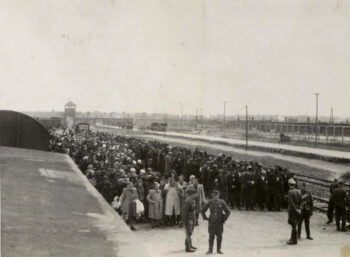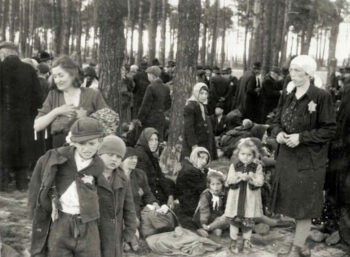Auschwitz Album
During the deportation of Jews from Hungary to the Auschwitz-Birkenau Camp, the camp administration decided to document what was happening with these deportees at their camp with a series of photographs. Hence, on 26 May 1944, photographers Bernhard Walter and Ernst Hofmann took a series of photographs of the fate of Hungarian Jews who arrived on that day at Auschwitz. Some 200 of these photos were eventually put together into an album titled “The Resettlement of Jews from Hungary.” The motivation for this is unclear. No other event or time period of the camp was ever documented with photos.
After the liberation of the Dora Camp by U.S. troops in early 1945, this album was accidentally found by the former Birkenau inmate Lili Jacob. She had been deported to Dora when Auschwitz was evacuated in January 1945. She claimed later to have found the album in the drawer of a nightstand in a former SS barracks at Dora, where she was recovering from illness.
Mrs. Jacob removed a few images allegedly showing relatives and acquaintances of hers, and then donated the album to Israel’s Yad Vashem Center in 1980. An unchanged archival edition was published in 1980, and then in 1981 the first edition for the general public. The album currently has 193 photos; 188 of them were included in the 1981 and later editions of this album.
The orthodox Holocaust narrative, based on numerous witness statements, has it that, on arrival of a deportation train at Auschwitz-Birkenau, SS men were waiting for them with guns and rifles drawn or clubs, sticks and whips in hand, and with vicious German shepherd dogs ready to tear into any uncooperative inmate. The inmates are said to have been received with lots of threats and yelling, with beating and occasional wanton executions, all employed to intimidate the deportees and accelerate the procedure.

Arrival of a train of Jews from Hungary at Birkenau. In the background, two crematorium chimneys without smoke. On the ramp, many deportees, hardly any SS guards, nor dogs, no rushing, no urging, no threats. A sunny, cloudless and smoke-free day.
During the arrival of the Jews from Hungary from mid-May to early July 1944, the Birkenau crematoria are said to have been strained to the maximum, belching thick smoke and even flames uninterruptedly. Still unable to cope with the huge masses of inmates getting killed every day, huge ditches are said to have been dug inside the camp (near Crematorium V) and just outside of its perimeter to the west (behind the so-called Zentralsauna). In those pits, massive pyres were presumably set up in order to burn thousands upon thousands of murdered Jews. As a result, the entire area was covered in thick, nauseating smoke.
Once out of the train, the inmates are said to have been told to leave all their luggage behind on the ramp, and line up in order to get “selected.” Those deemed fit for work were allegedly sent to one side, those unfit to the other. The latter group is said to have been directed immediately to one or several of the many claimed gas chambers.
The photos taken by the SS of the arrival and processing of a train full of deportees from the Carpathian Mountains show the exact opposite. The sun is shining on all photos. There is no smoke in the skies, except near where the train’s locomotive is (near the camp’s main entrance, hence at the opposite end of where the smoke should be). Several photos show the chimneys of Crematoria II and III, the camp’s largest cremation facilities. They do not emit any smoke, let alone flames. This impression is confirmed by many air photos taken at that time.
Most images show no SS men at all. If some are present, they are a minute minority within a sea of inmates. None of the SS men have whips, clubs or truncheons. None of them have any weapons drawn. There are no dogs visible anywhere. The SS men interact normally with the inmates. There is no rushing, urging or threatening behavior visible in any of the photos.
 On the ramp, women and children lined up next to the train, men on the other side. A sunny, smoke-free day.
On the ramp, women and children lined up next to the train, men on the other side. A sunny, smoke-free day. Peaceful, calm guards. A sunny, smoke-free day.
Peaceful, calm guards. A sunny, smoke-free day. Woman with little children and luggage. A sunny, smoke-free day.
Woman with little children and luggage. A sunny, smoke-free day.The inmates lined up on the ramp in two groups: men and older boys on one side, women and smaller children on the other. Hence, the first selection on the ramp was by gender, not fitness. However, an entire section of the album shows groups of inmates divided into men fit and unfit for work, as well as women fit, and women with small children unfit for work. Hence, there evidently were two selections happening: One very superficial by gender on the ramp, and later another one according to physical fitness or the need to care for little children.

Mainly women and children waiting in the woods. A sunny, smoke-free day.

Men (top) and women (bottom) fit for work, shorn, bathed, disinfested, with inmate clothes.

Several photos show old and young women with small children on their way from the ramp to unknown destinations along some camp road. Interestingly, some still have their luggage with them. Had they been slated to go to the next available gas chamber, they would not have been allowed to clog the mass-murder process by bringing along their sacks and bags and suitcases. Clearly, for these Jews unable to work, the journey wasn’t over.
The album shows how these deportees gathered in a wooded area, sitting on the grass among trees, evidently relatively relaxed, recovering from the strenuous journey, calmly waiting for something to happen. The only wooded area inside the Birkenau Camp was in its western part near and around the Crematoria IV and V, put also near the camp’s largest disinfestation facility, the so-called Zentralsauna. Hence, this is probably where these photos were taken.
Therefore, these deportees were either waiting to be gassed in the gas chambers claimed to have existed inside the two crematoria nearby, or they waited to be disinfested and showered in the Zentralsauna before continuing their journey elsewhere. If the orthodox narrative were true, then these Jews evidently had to wait because the gas chambers weren’t ready for them yet. The previous batch still had to be dragged from these chemical slaughterhouses. Hence, claimed dramatic scenes of hundreds and thousands of gassed Jews being dragged out of these crematoria into the yard, to be burned on pyres, would have been visible to the Jews waiting outside for their turn to be slaughtered. Moreover, the flaming, smoking, crackling, stinking inferno caused by the gigantic pyres allegedly blazing behind Crematorium V and behind the Zentralsauna near the alleged Bunker 2 could not have gone unnoticed by anyone. It certainly would have caused panic among the waiting deportees, and inevitably would have left smokey traces on the photos. But none of it is visible on these photos.
The album also follows the path of those deemed fit for labor: they had their hair shorn, were disinfested, received prisoners’ clothes, and were then assembled, probably to be told what awaited them next.

Shorn female inmates fit for work awaiting instructions. A sunny, smoke-free day.
The editions of the Auschwitz Album available for purchase all have misleading comments and a rearranged sequence of photos. This was evidently done in an attempt to insinuate to the reader that what they see in the picture is not what happened. Rather, this album is allegedly part of just another evil plot by the SS to hide their intricate plans for the deportees’ mass murder behind innocuous-looking photos.
(All photos taken from the Yad Vashem website; see Mattogno 2023c, Chapter 1.10; Faurisson 1983.)

You need to be a registered user, logged into your account, and your comment must comply with our Acceptable Use Policy, for your comment to get published. (Click here to log in or register.)